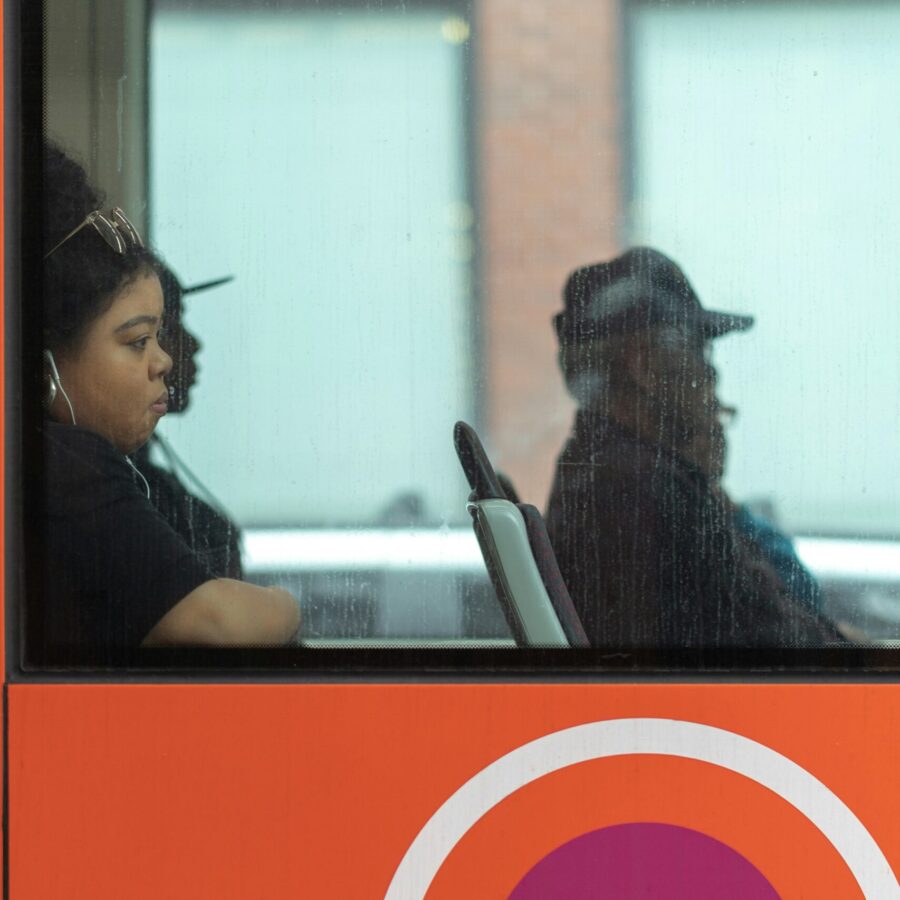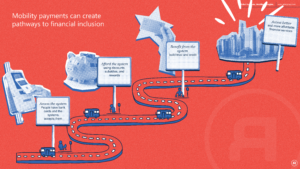Rethinking Financial Equity: Mobility Payments as a Gateway to Financial Inclusion

Transportation equity is a fundamental consideration driving the transportation industry, and the role we play in delivering impact to the communities we serve. While the focus is often around the quantity and quality of mobility options that communities can access, how people pay for transportation is also a critical part of increasing the equity and inclusivity of our transportation system. This article explores how mobility payments can serve as a gateway to financial inclusion, and outlines both proven and emerging tools for transportation agencies and mobility providers to deploy to offer financial benefits that can extend far beyond mobility itself.
Transportation drives our collective access to opportunity, from jobs and education to recreation and community services. When it comes to equity in transportation, the first instinct is to focus on access to mobility services: do people have reliable, safe, convenient transportation options nearby? But how people pay for those transportation options is also a critical, and often overlooked, aspect of transportation access. How – and how much – vulnerable riders pay to access mobility services has a profound influence not just on travel choices, but on quality of life and access to opportunity more broadly.
To address this, American mobility service providers have traditionally focused on accepting cash and providing discounts to certain customer groups. But today, new payment solutions can not only improve access to transportation services, but also create opportunities to improve people’s financial well-being. This is largely due to the rapid evolution of the payments industry in the US in recent years. Contactless payment options, also referred to as “open loop payments,” have expanded and now allow people to pay for mobility the same way that they pay for groceries and other everyday items. For many, credit or debit cards or smartphone wallets are quickly becoming the preferred way to pay for transit – as shown in big cities like London and New York – and are being launched on systems of all sizes around the world. Further, both traditional and new financial technology, or “fintech,” players are increasingly offering products tailored for lower income customers and those new to banking, enabling payment options that were not available just a few years ago.
With nearly 6 million unbanked and 19 million underbanked adults in the US, paying for mobility could be a gateway to unlock financial inclusion opportunities. Instead of continuing to pay cash or requiring riders to lock money into purpose-built transit cards or mobility apps, we can point customers to payment options that increase their familiarity with financial services and allow them to build trust with financial institutions. Below we outline the key steppingstones – and tools to employ along the way – that demonstrate how payments in mobility can forge pathways to financial inclusion.

1) Can I pay? Getting access to the payment's ecosystem
The first step is ensuring that transportation providers accept bank cards, and that riders are familiar with how to use to them.
Contactless payments are now ubiquitous worldwide. Most of our daily purchases – from restaurants to gas stations to grocery stores – allow this as a payment option. This same trend is increasingly true for mobility providers, who see value in fulfilling customer expectations around paying for transportation in the same way as other everyday items, and seek a variety of financial, operational, and customer service benefits that come from accepting contactless payments. Public transit agencies globally are accepting bank cards on bus and rail. For drivers using electric vehicle (EV) charging, the state of California led what is now a national standard requiring public EV chargers to accept bank cards rather than only accept payment via a mobile app. Nearly all bikeshare and microtransit service providers accept bank cards. While not ubiquitous across all modes, transportation providers are increasingly focused on deploying contactless payments to increase the ease of paying for their services.
As mobility services provide people with access to their communities, it’s essential to find contactless payment offerings that work for the millions of un- and underbanked Americans. Fintech services offer low-barrier ways to translate cash into a contactless payment method. Specifically, fintech providers like the Cash App, Chime, Venmo, and more offer customers a means to make transactions without a bank account or prior credit history. In 2021, Monterey Salinas Transit (MST) partnered with the California Integrated Travel Project (Cal-ITP) to launch contactless payments across its fleet, which included partnering with Cash App to provide a contactless bank card for riders that need one.
Helping people pay for small mobility purchases is also a great way for them to become more familiar with contactless payments. In a partnership with the State of California and Valley Clean Air Now (Valley CAN), 100 electric vehicle (EV) owners were given reloadable contactless debit cards to help increase affordability of their charging needs. As a result of the initiative, 90% of participants noted that they were now more comfortable using digital payments than they were before the program.
2) Can I afford the system? Delivering discounts, subsidies, and rewards via open loop
The next step is linking affordability measures to the ways that riders want to pay.
Most transportation affordability measures to date have focused on offering discounts to specific travelers. In fact, for transit agencies looking to receive federal funding, agencies are required to offer reduced fares for seniors and persons with disabilities. Traditionally, these discounts are offered if travelers register on each system or service they use to verify their eligibility, which typically requires travelers to pre-purchase a pass or allocate funds on a closed-loop card that can only be used for transit. Now, some agencies have begun streamlining their digital eligibility processes and linking discounts to open loop cards. This means that riders can verify that they qualify for a specific discount and link their bank card to receive discounts on a pay-as-you-go basis. Monterey Salinas Transit (MST) has successfully linked senior discounts to bank cards, while New York MTA is deploying discounts for all rider groups on the new OMNY open payments system. This is a significant improvement for the customer experience, allowing travelers to get access to affordable mobility while paying with what they have in their wallets today.
Another way to increase affordability is to provide subsidies for travel, which can be delivered efficiently and safely via bank cards. The Los Angeles County Metropolitan Transportation Authority (LA Metro) and the Los Angeles Department of Transportation (LADOT) have deployed the largest distribution of pre-paid debit cards in the country as part of a “mobility wallet” to residents of South Los Angeles, allowing people to choose to move freely across modes, including transit, commuter rail, transportation network companies (TNCs) and bikeshare.
Beyond discounts and subsidies, mobility providers are also looking to promote loyalty and incentivize sustainable travel behavior. As successfully demonstrated through the financial sector on a variety of services, there is the opportunity to link spending on qualifying transportation purchases to a cash back or rewards program. Each time a customer uses mobility services like transit, bikeshare, or EV charging, they could receive a percentage cash back or points that are linked to their bank card, which they can then use to pay for other goods and services. This model is already underway with card providers like Futurecard, who offered 100% cash back on the New York subway during December 2023 and January 2024. This cash back rewards model could also serve as an efficient way to rethink the distribution of benefits and create incentives to achieve mode shift goals. Imagine, instead of an agency needing to frontload benefits on a pre-paid card or check, they could be channeled through a 100% cash back rewards scheme, which could facilitate better tracking and verification of relevant purchases. These concepts are under exploration as part of the Mobility Loyalty & Rewards Market Sounding conducted by Cal-ITP and the California Air Resources Board (CARB), with the intent to launch a rewards demonstration in the future.
3) Can I benefit from the system?
To expand financial inclusion beyond mobility, it is essential to help people build trust with financial institutions and facilitate credit-building opportunities.
In the modern economic landscape, access to credit plays a crucial role in financial success, facilitating everything from buying a home, paying for education, and managing unforeseen emergencies. While many un- and underbanked Americans don’t have access to traditional credit-building products, secured credit cards offer one solution to bridging the gap between traditional banking systems and those who have limited or no credit history. Unlike traditional credit cards, they require a security deposit, which acts as a credit limit for the user and a safety net for both the issuer and the user. By design, this structure minimizes the risk for the lender while granting consumers the opportunity to build or rebuild their credit. By using the card responsibly and making payments on time, cardholders can build a positive credit history and transition to traditional financial products, e.g. credit cards. This tool not only facilitates (re) building someone’s credit profile but also enables them to gradually qualify for many other financial advantages, including lower interest rates on significant purchases.
Secured credit cards are already a proven product for those that need them. According to a 2021 Consumer Financial Protection Bureau (CFPB) report, nearly one-third of consumers with subprime credit scores (below 600) in the US have at least one secured credit card account. Now, future opportunities lie in connecting mobility benefits to secured credit cards, allowing travelers to graduate from receiving benefits from tools like pre-paid debit cards and onto a platform that offers the chance to build a financial footprint that can be recognized by lenders, landlords, employers, and others, for broader access to opportunity.
4) Can I get access to more (and more affordable) financial services?
Mobility can serve as the “bankable moment” that offers pathways to broader financial inclusion.
For travelers who want to move beyond spending and into saving, opening a bank account is a vital step. While bank accounts have historically required significant personal information (like a social security number), account opening fees and annual maintenance fees, many banks and credit unions are moving away from those requirements. Launched under the Cities for Financial Empowerment (CFE) Fund, a non-profit focused on expanding the availability and affordability of banking products, Bank On lists certified banks and credit unions with services and products tailored to un/underbanked customers that feature lower fees and minimum requirements.
The power of getting people banked extends far beyond mobility. It encourages savings that help people weather unforeseen costs, it can reduce the fees they pay for transactions, and help them build credit to make financing investments like education, housing, and car payments more affordable. Paying for mobility can enable a powerful “bankable moment” by increasing the awareness of and incentives to banking for un- or underbanked travelers currently paying cash on the system today. Transit agencies can help solve the underlying payment challenges by helping them get banked by suggesting affordable bank accounts and/or incentivizing bank accounts through programming.
Access to transportation means access to everyday opportunities, and that rests on making transportation payments easier and more inclusive for everyone. There are new tools available and new partnerships underway, but there is still much more work to be done. Together, we can unlock new opportunities for upward mobility, which can start with mobility itself.


